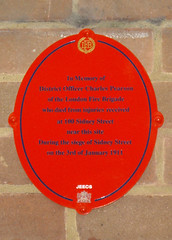Commemorated on 2 plaques
In memory of District Officer Charles Pearson of the London Fire Brigade who died from injuries received at 100 Sidney Street near this site during the Siege of Sidney Street on 3rd January 1911
Sidney Street, London, United Kingdom where it was fought (1911)
Painter House. This block was built in 2006 by Tower Hamlets Community Housing and named after Peter Piaktow, who was know as Peter the Painter, anti-hero of the nearby Sidney Street Siege in 1911
Sidney Street, London, United Kingdom where it was near (1911)

